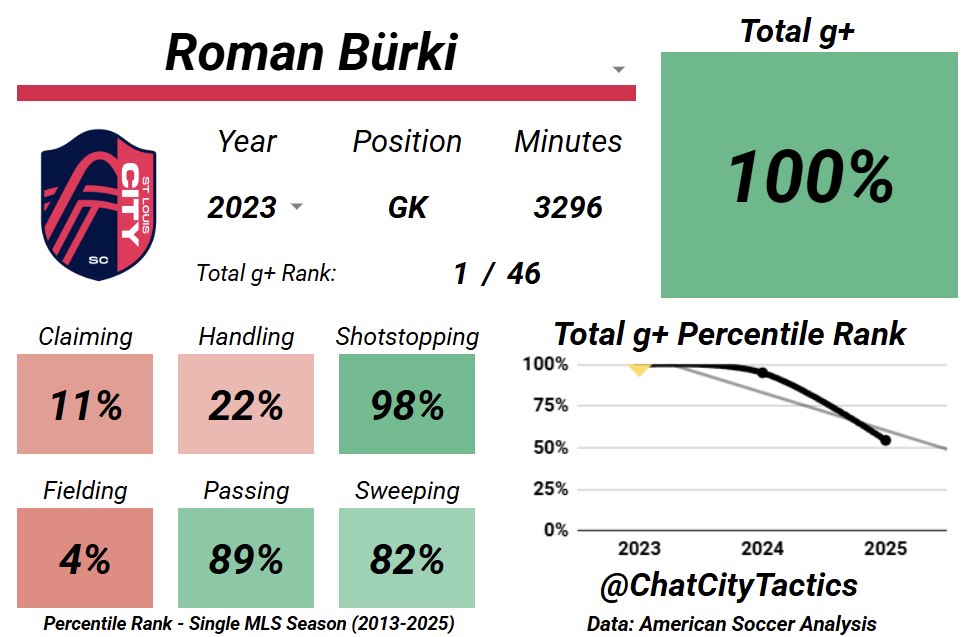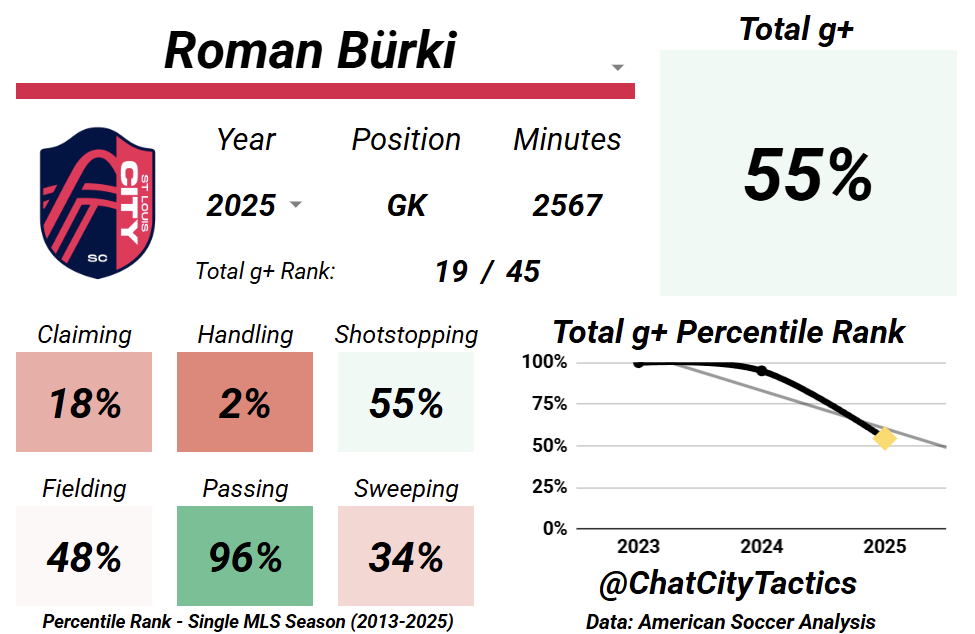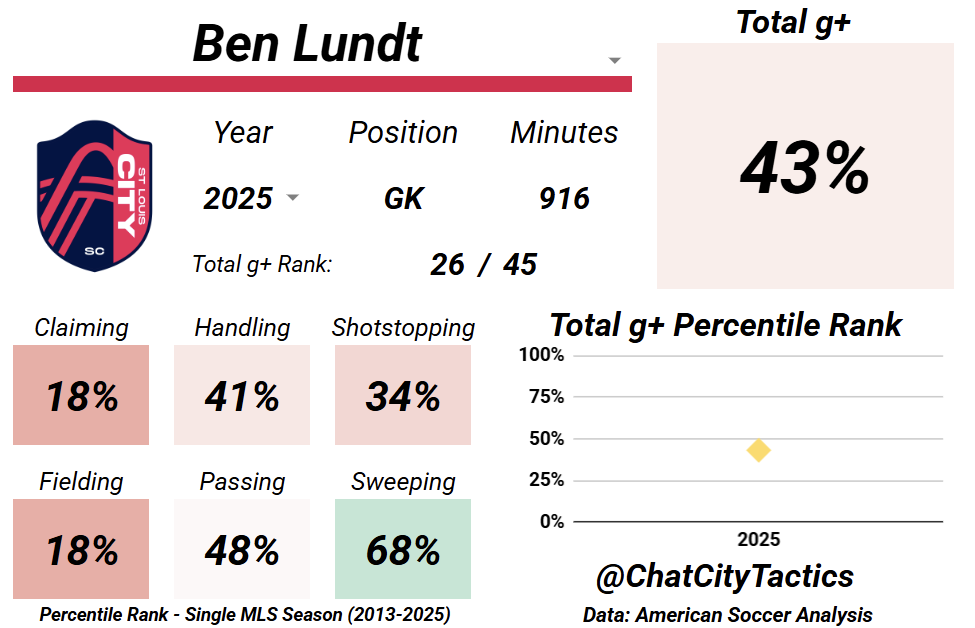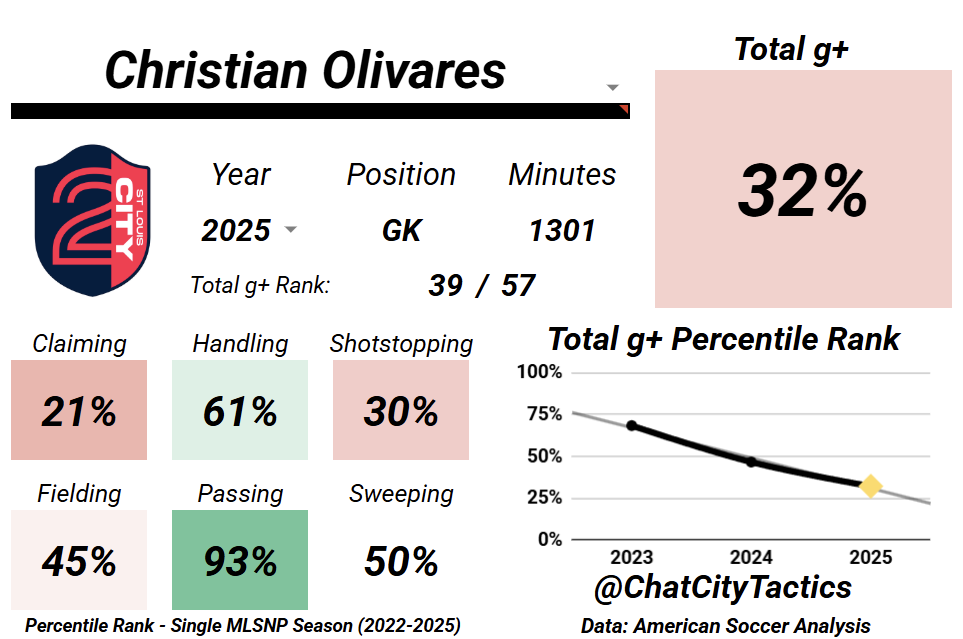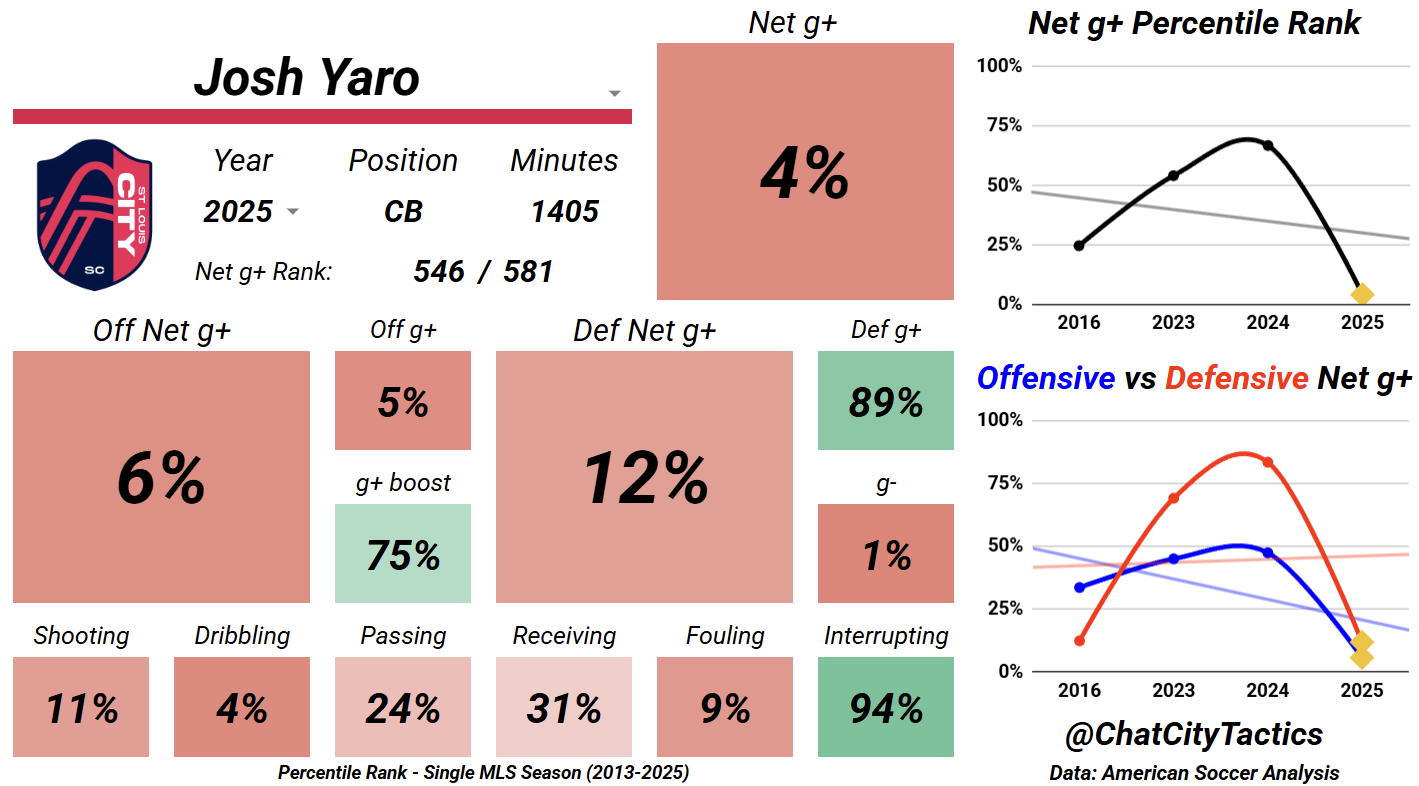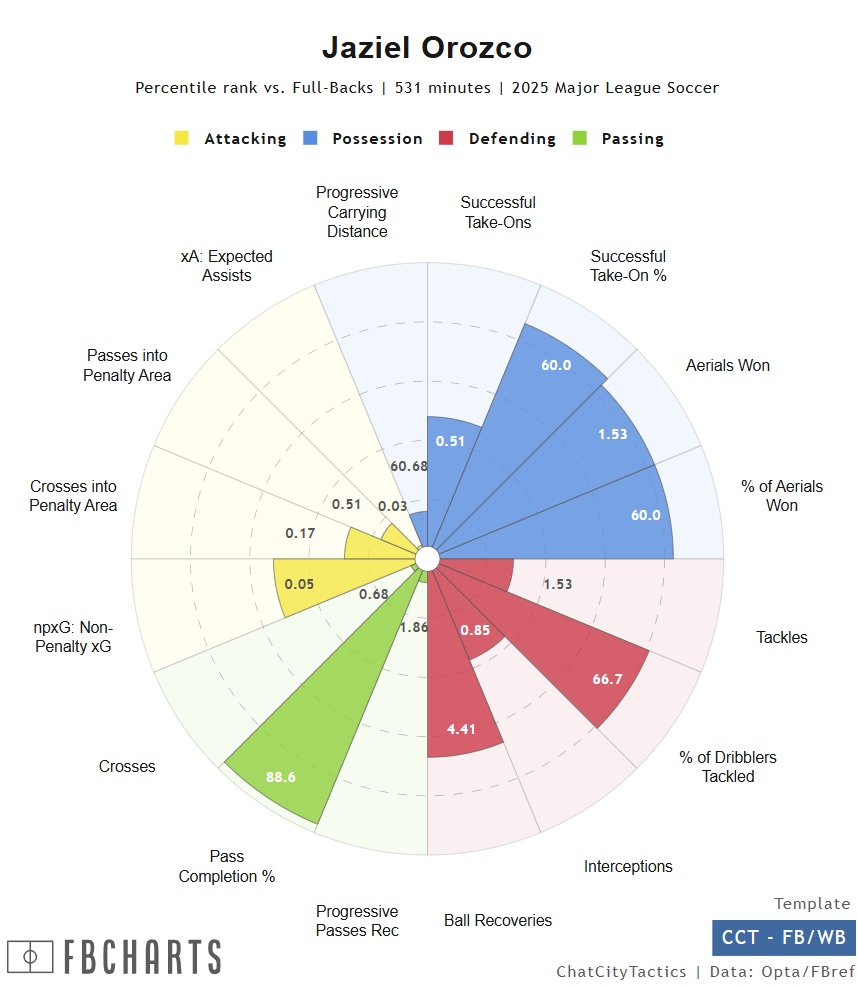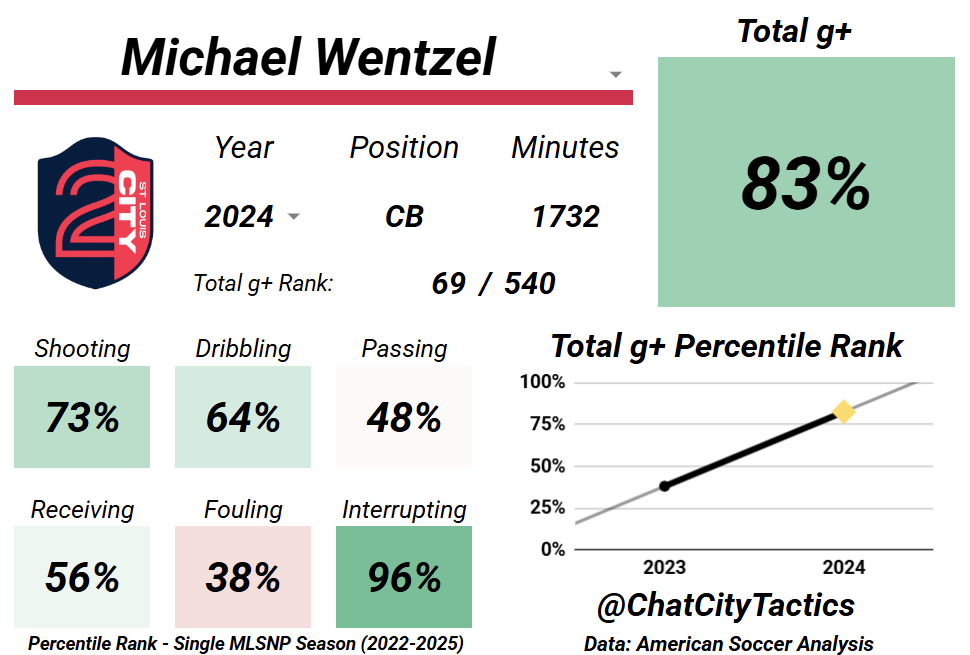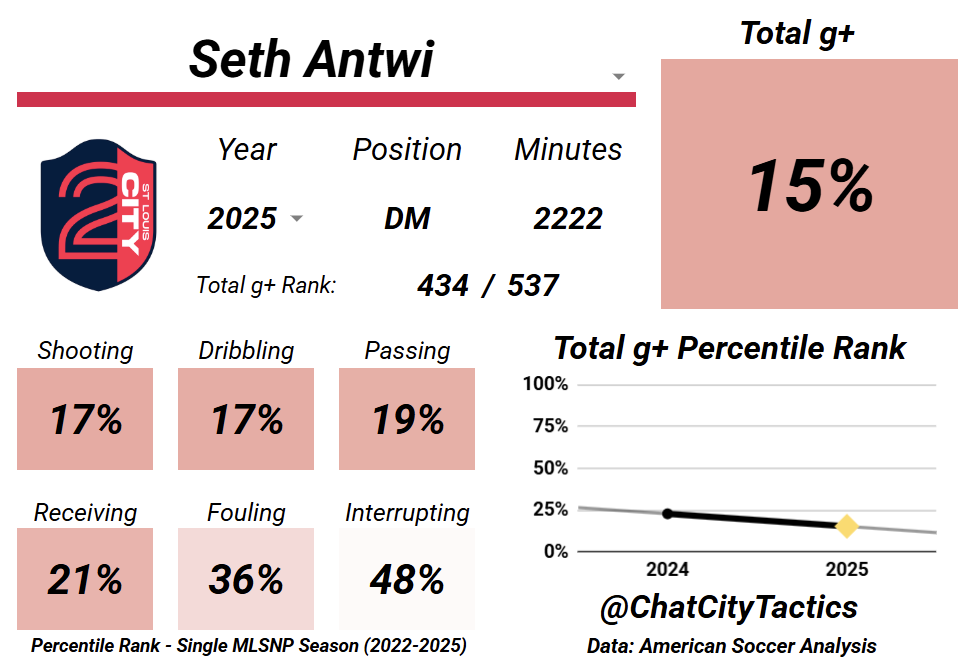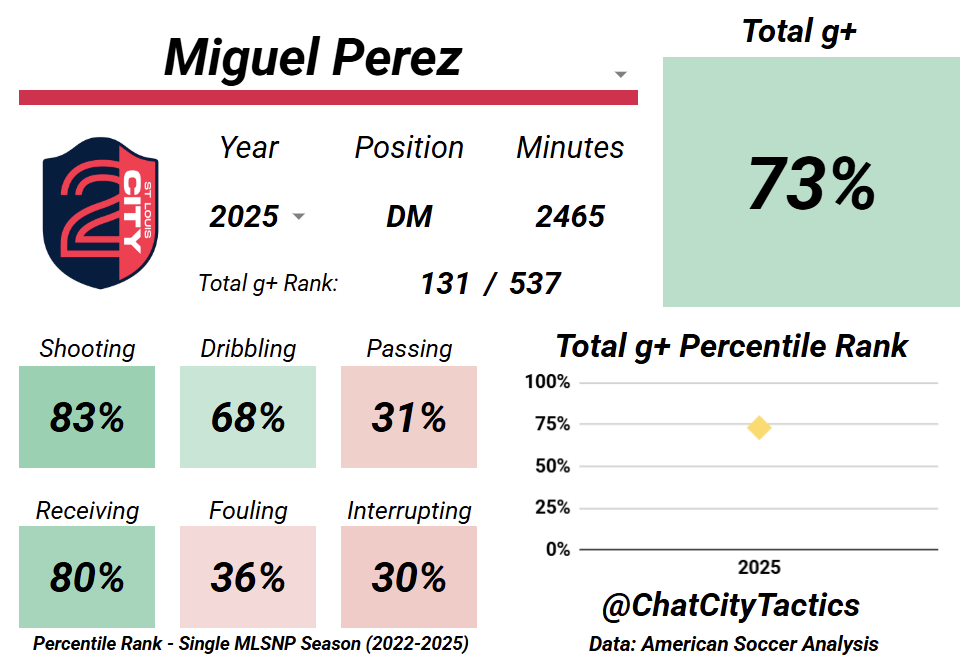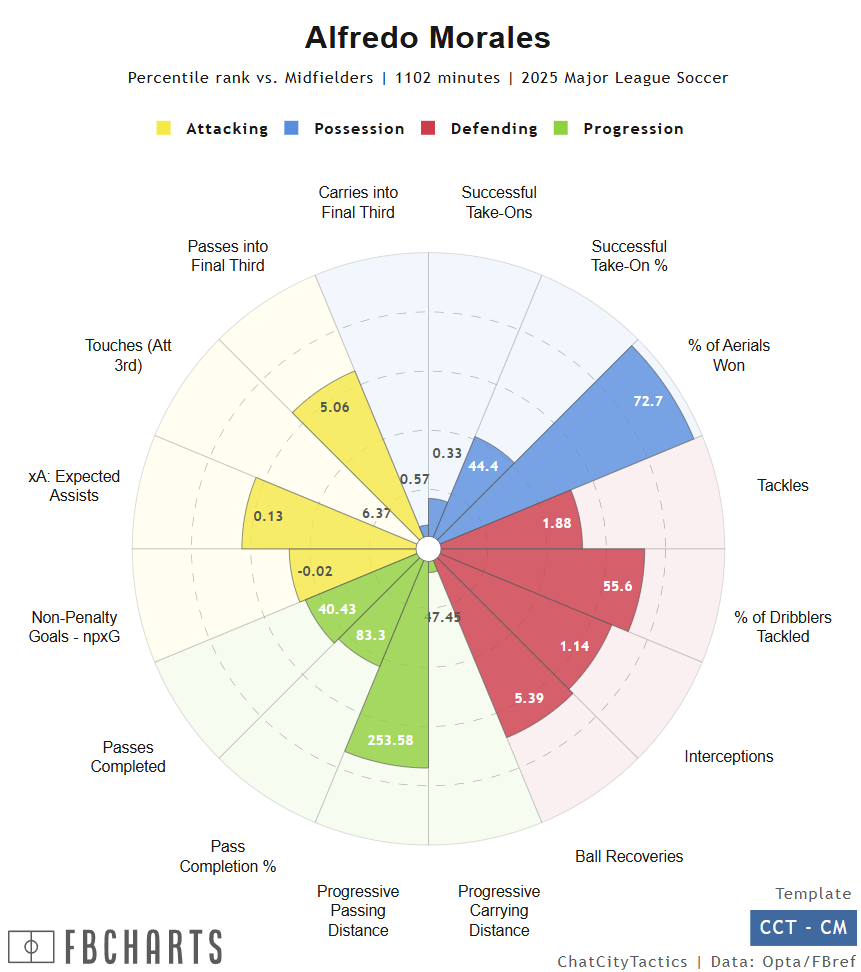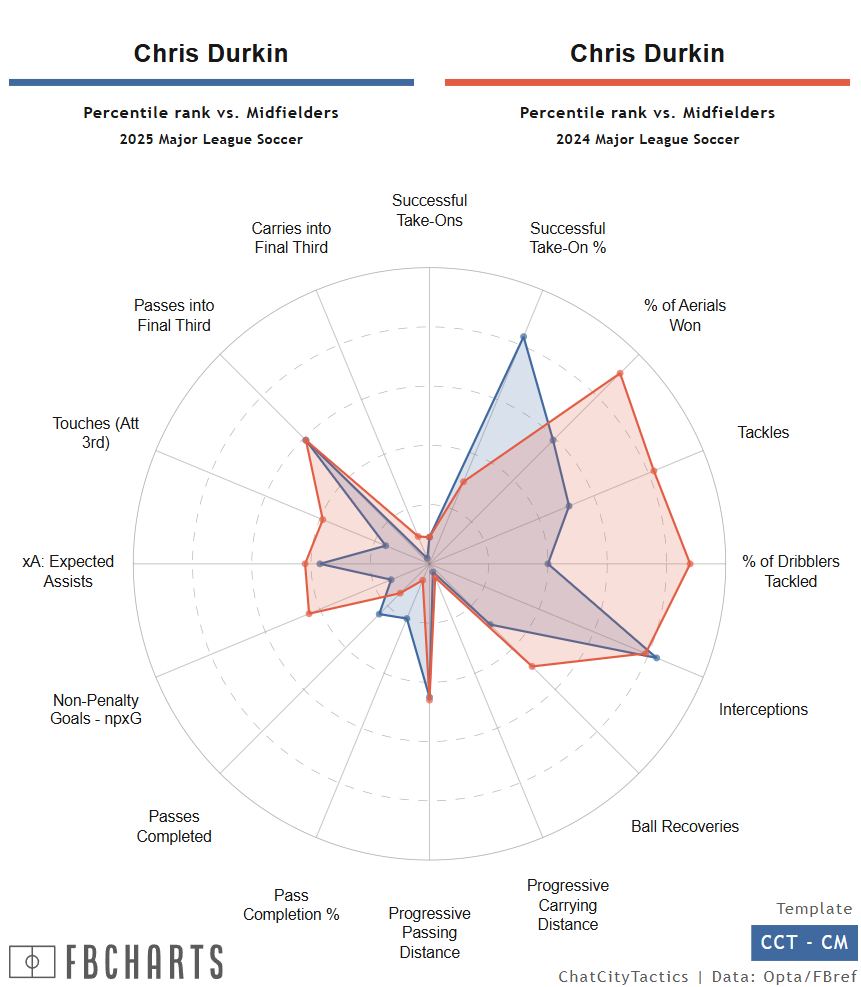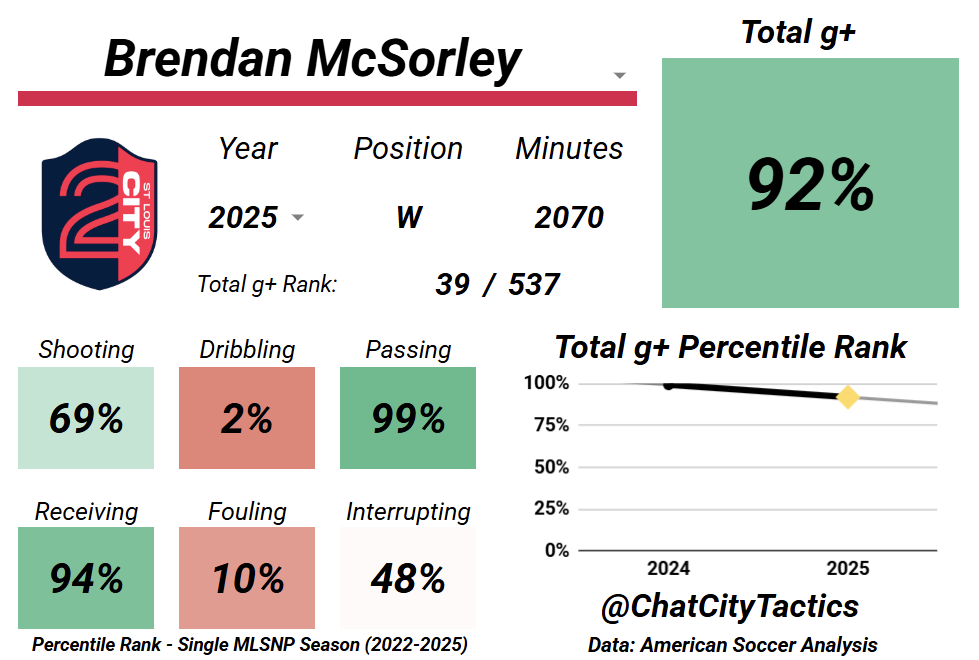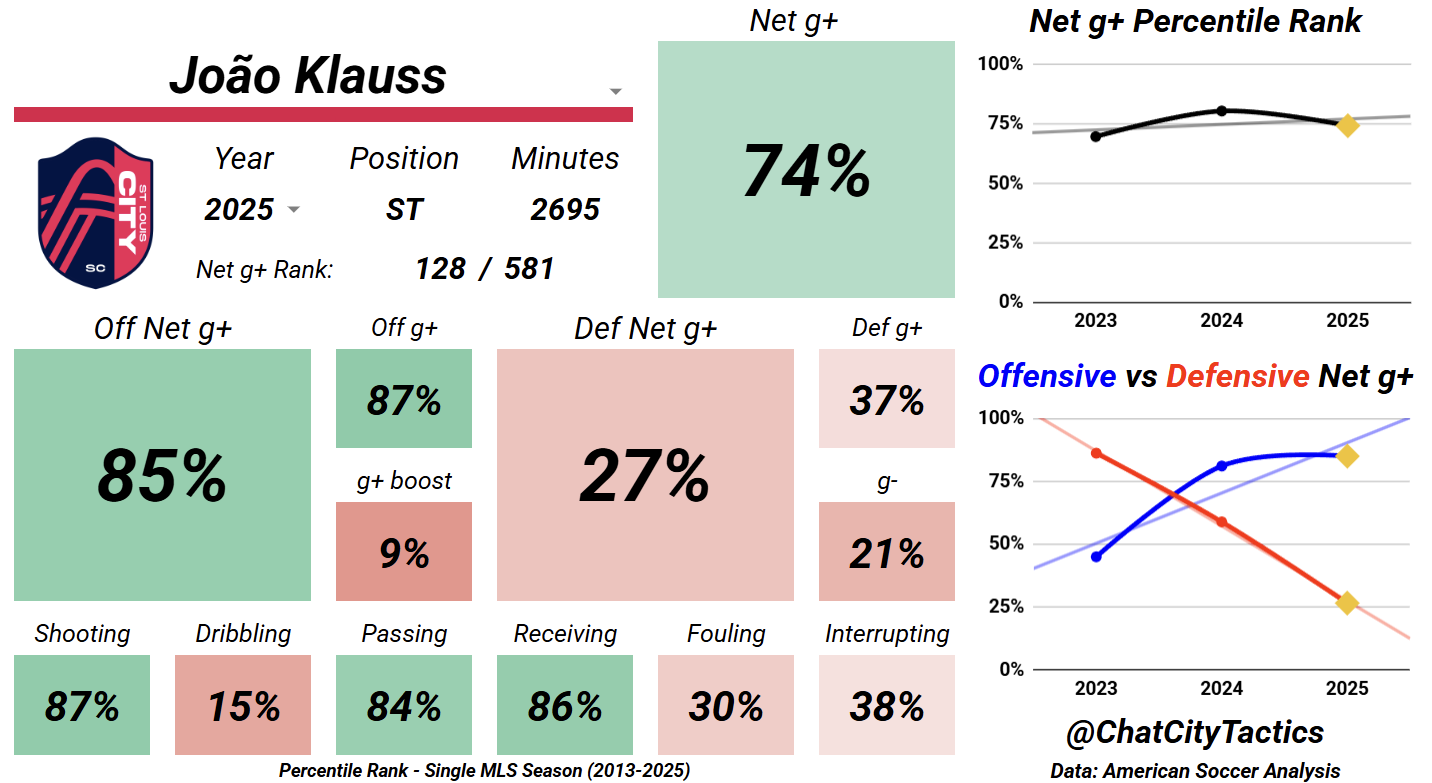Hello Offseason. Hello #AllForCITY.
You’ve probably heard of Jesus of Nazareth and the timeless question: What Would Jesus Do?
Allow me to introduce Michael of Washington, Missouri — and a new gospel for the CITY faithful:
What Would Michael Do?
The 2025 offseason is here.
The roster? Unknown.
The cap? Unknown.
The club’s identity? Unknown.
The manager? Unknown.
And the front office? Also… unknown.
This series exists to provide my answers to some of those unknowns.
The first edition of WWMD is a player-by-player breakdown of STL CITY’s roster — centered around one critical question:
Should the club exercise this player’s option for 2025?
We’ll look at:
Position, age, contract status, and salary
Performance vs. cap hit
Tactical fit and long-term upside
WWMD verdicts: Keep, decline, renegotiate, or trade
This isn’t just about cutting dead weight — it’s about building a smarter, sharper, more competitive squad for 2026 and beyond.
Because what we’ve seen lately? It simply hasn’t been good enough.
So grab your rosary beads and your roster spreadsheet.
It’s time to ask the only question that matters in the CITY offseason:
What Would Michael Do?
Goalkeepers
Roman Bürki
Probably the single largest question mark of the 2025 offseason. The Captain. The cornerstone. The face of this club so far. Once the only DP goalkeeper in the league — and still CITY’s second-highest-paid player.
He’s 35 now and made $1.7 million in 2025, the final year of his contract.
In 2023 and 2024, there was no doubt he earned the right to be the league’s highest-paid goalkeeper. Whether that premium — roughly 36% more ($458K) than the next-highest-paid — was justified is another debate entirely. But the facts back him up.
In 2023, Bürki was MLS’ best. His +0.28 PSxG-GA ranked in the 97th percentile. In 2024, he followed it with +0.25 (96th percentile). A positive number like that means one of two things: luck or elite shot-stopping. We’ve seen enough to know it was the latter.
This year, at 34, the regression finally arrived. His +0.07 PSxG-GA still suggests above-average shot-stopping, but the percentile dropped to 59th.
That’s from OPTA/FBREF, and the American Soccer Analysis Goals Added cards tell the same story.
Some will ask: Wasn’t that just because CITY’s defense wasn’t good?
Probably not. xGA was 57.4 in 2024 and 57.3 in 2025 — basically identical. The team around him didn’t suddenly collapse; the keeper simply regressed.
Is it a blip? Could he bounce back at 35 and beyond? Possible. But not probable.
So what do you do with a goalkeeper this important — to the locker room, the fanbase, and the club’s identity?
You re-sign him — but smartly. This isn’t about nostalgia. It’s about building a sharper, more competitive roster for 2026 and beyond.
I’d offer a 2 + 1 extension (through 2027 with an option for 2028). Sit him down, share the vision (which the club currently lacks), and find common ground on a reduced salary that gives CITY flexibility to actually improve.
Because, bluntly, no other MLS club would pay a goalkeeper that much. If Bürki wants to stay in the league, his options are here — or a massive discount elsewhere.
WWMD: Contract Extension. 2 + 1 deal at ~$1.5 M AAV.
And when it’s all said and done, he walks away on his terms — the first captain of St. Louis CITY SC.
Danke, Roman.
(Editor’s Note: This is, of course, not what CITY actually did. With Gigliani and Hackworth steering the ship, the extension was indeed a 2+1 — but somehow, they gave him more money, made him a DP again, and rumors suggest he’ll once again be CITY’s highest-paid player. My grade on that decision: D.)
Before we get into Big Ben, here’s what I want out of my backups.
If the starter goes down or needs a rest, the backup should be able to come in and do the same job — not as well, but well enough.
Backups shouldn’t reinvent the system or need the entire XI to change around them. They should just step in, play the role, keep the floor from falling out, and get out alive.
Competent. Reliable. Worse — but still functional. That’s what I ask.
Ben Lundt
His $172,833 senior contract expires this year and has no future options.
For all intents and purposes, Ben seems like a great guy — great in the locker room, good teammate, all that.
I don’t care.
Fans know next to nothing about locker room dynamics. We see a TikTok of guys goofing around and suddenly someone’s a “culture guy.” We don’t know. We guess.
Ben, as the backup to Roman, has to fit my criteria for a backup in this exercise:
Competent. Reliable. Worse. Functional.
Competent? Absolutely. He showed this year that MLS isn’t above his level and qualified for his first g+ card.
Reliable? Yep. He’s consistent. Fans, teammates, coaches — they all know what they’re getting from Ben week in and week out.
Worse? Obviously.
Functional? That’s where it falls apart.
If you recall from those Roman cards — or from watching him the past three seasons — he’s an elite ball-player. He can hit passes with either foot, stay composed under pressure, and facilitate play from the back — something CITY wants to do.
Ben can’t do that. He requires a different playstyle when he’s on the pitch. You can’t pass back to him, expecting calm distribution and buildup. At 30, there is little expectation of development in that regard, either. And I can’t have that in my backup, because backups shouldn’t force the system to change.
So Ben — thank you, and best of luck.
WWMD: Release.
(Editor’s Note: CITY released Ben, but has said they’re discussing a potential return. Grade: B.)
Christian Olivares
Outside of a few die-hards, most fans probably haven’t even heard of this young man. He’s not quite Big Ben, but at 6’4”, he’s got plenty of size.
He’s on an expiring contract at the reserve minimum ($80,622), with club options for 2026 and 2027 — and most importantly, he’s registered on the supplemental roster, not the senior one.
Looking at his Goals Added (g+) cards over the past three seasons, it’s notable how much his passing has improved — once a weakness, now arguably his biggest strength. Questions about his shot-stopping remain, but he appears capable of playing the facilitator role, which matters a lot to me.
WWMD: Exercise the 2026 option. Keep him on the supplemental roster. It frees up a senior slot and keeps the cap hit minimal, which is critical if you’re spending truckloads on your starter.
If Olivares ever needs to start, use short-term call-ups to bring a CITY2 keeper (Welsh) up in reserve. Some leagues require three goalkeepers. MLS doesn’t. So don’t waste a roster spot on one.
(Editor’s Note: CITY exercised the 2026 option. Grade: A.)
Goalkeepers done. Time to talk about the guys standing in front of them — at least, the ones who are supposed to make their lives easier.
CITY’s defensive unit has been… something. Equal parts chaos and commitment, sometimes heroic, sometimes tragic, and almost always busy.
But let’s get this straight: defending in this system isn’t just about blocking shots or winning duels. It’s about structure, spacing, and decision-making under pressure. And lately, we’ve had more of the last one than the first two.
So as we move through the defenders, the lens stays the same:
Are they good enough to play the role asked of them?
Do they fit the system we claim to be running?
And do they help build a backline that doesn’t need a superhuman in goal to survive?
Let’s get into it.
Defenders
Henry Kessler
At 27, Henry Kessler is the best center back at the club — by some distance.
I also think he’s one of the best ball-playing center backs in MLS and, when healthy, should be in the USMNT conversation (especially when you look at some of the names that get called up). But that’s the catch — when healthy.
There’s a sick, cruel irony in the fact that CITY has, in pure talent, had two of the better center backs in this league… and neither one can stay on the field.
Over the last three seasons, Kessler has started 46 of a possible 102 matches — just 45%.
CITY traded fan favorite Tim Parker for Kessler for three reasons:
He’s younger.
He fits the system better.
He’s better.
But in doing so, they also took on a hefty contract. His salary sat at $1.33M in 2025, and reports suggest his 2026 option includes a significant raise on top of that.
That’s expensive. Really expensive. Especially for a club that just bit the bullet and ate money owed to another injury-prone (but talented) center back.
It feels like forever ago, but remember back in February and March — fans were clamoring for Kessler to make the Team of the Matchday without even scoring. He was everywhere. That early form didn’t even showcase his expansive passing range, which remains elite among domestic CBs.
His g+ card backs it up: in just 1,551 minutes, his defensive work was unparalleled among MLS center backs.
But again — that option is expensive.
WWMD: Decline the option, but negotiate an extension (2+1) around $1.4M AAV. Keep him through age 30.
(Editor’s Note: Option was declined, and CITY is reportedly discussing a potential return. Grade: C. Improves if they land the details right; it’s an F if he walks.)
Josh Yaro
Josh Yaro has been here since the beginning — a day-one guy, a leadership presence, and by all accounts, a genuinely good human being.
But good humans don’t necessarily make good defenders.
At 30 years old, Yaro’s profile is what it’s been for years: an athletic, undersized center back with recovery speed, decent positional instincts, and limited ability to progress the ball under pressure. You can love him as a person and still admit that his on-field ceiling was reached a long time ago.
In 2023, he got the “emergency starter” tag and wore it well. In 2024 and 2025, he became a recurring feature in lineups that badly needed an upgrade. The problem? When Yaro plays heavy minutes, it’s a symptom — not a plan.
And in 2025, Yaro put up one of the worst seasons in MLS history according to g+. Of the 5,860 players who have met the five-game threshold for a CCT card, 5,509 (95%) have posted a better individual season than Yaro’s 2025. He finished as a bottom-40 player in the league, with a Net g+% of just 4%.
Tactically, he’s misaligned with how CITY want to play. He’s not comfortable breaking lines with the ball, and when pressed, he defaults to clearances and long balls. That’s fine in certain systems — just not the one St. Louis keeps insisting it runs in the post-Carnell era.
Defensively, he’s serviceable in low blocks or emergency cover, but his timing in duels and lack of aerial presence make him a liability against strong or tall forwards. Combine that with CITY’s tendency to compress the pitch, and it’s a bad fit for everyone involved.
At this stage, Yaro’s role should be what it always should’ve been — a guy on the outside looking in. He hasn’t seen the pitch since July 19th. And if CITY want to evolve, those minutes have to go to younger, more system-fitting defenders.
His $200k contract expires this year, and he has an option for 2026.
WWMD: Decline the option and release. Thank him for his service, his professionalism, and his 10,000 miles of running behind a broken press. Wish him well — preferably in a league or system that suits his skill set.
(Editor’s Note: CITY declined Yaro’s option. Correct decision. Grade: A. CITY is reportedly discussing a potential return — if that happens, the grade drops to F.)
Jaziel Orozco
A promotion that got a lot of people excited.
Jaziel hit the ground running by doing one simple thing — not making mistakes. And because CITY make a lot of mistakes, that got the people going. So much so that he earned a bump from CITY2 to the supplemental roster, signed through 2025 on a reserve-minimum deal (like Olivares above), with options for 2026, 2027, and 2028.
And then… he started making mistakes.
Those compounded with the fact that he wasn’t really doing much of anything on the pitch. CITY brought in a loanee to play Orozco’s position without an option to make that loanee permanent — which tells you how they evaluated his play — and his minutes all but dried up over the final two months.
So what is Orozco in 2026? He’s the break-glass-in-case-of-emergency defender. The third left back. The third right back. The fifth or sixth center back. He’s a body when you need a body — and he’ll be perfectly serviceable in that role.
Is that the role he envisioned or dreamed of? Definitely not. But I’m in the business of building a competitive roster, not a sentimental one. And that’s that.
(Editor’s Note: CITY exercised his 2026 option. Grade: B — as long as everyone understands he’s not meant to play a meaningful role.)
Michael Wentzel
The original Jaziel Orozco.
In an era when CITY had no healthy center backs under Bradley Carnell, Wentzel weirdly stayed on the sidelines. Then — in what we can only assume was pure coincidence — just hours after Carnell was sacked, Wentzel received his promotion to the supplemental roster.
He’s appeared in six matches over the past two seasons, totaling 271 minutes. In those limited minutes, he’s looked the part of a depth center back: a bit plodding and slow, but calm on the ball and technically solid. He put up good numbers in MLSNP, and should be able to find a home with another NP side or in the USL.
He was under contract in 2025 on a reserve-minimum deal, with a club option for 2026.
WWMD: I didn’t see a reason to have both Orozco and Wentzel on the same roster in 2025, and I don’t see one in 2026. Wentzel profiles better as a pure center back, but Orozco’s added positional flexibility gives him the edge for that supplemental slot, which needs to prioritize versatility.
(Editor’s Note: CITY declined Wentzel’s option. Correct call. Grade: A.)
Joey Zalinsky
A second-round draft pick in 2025, Zalinsky was immediately signed to a supplemental-roster contract on the reserve minimum ($80,622), with options for 2026, 2027, and 2028.
At first, I was surprised he signed a senior-team deal right away — a sign that the staff believed he was ready to contribute real minutes.
Well… that never happened.
Starting right back Totland missed serious time with injury. That didn’t matter. Joey played in seven matches, totaled 221 minutes, and didn’t feature for CITY2 either. In the end, he became part of a familiar theme from the Lutz Pfannenstiel era — a wasted roster spot.
Did the front office misfire by giving him that deal so early?
Did the coaches mismanage him by not playing him in MLS or MLSNP?
Who knows.
WWMD: This one could go either way. Because he’s cheap and under control, I’d lean toward exercising his option and seeing if he can actually provide fullback depth in 2026 — but I’d understand if they cut him.
(Editor’s Note: CITY is currently discussing his contract option. Grade: N/A.)
Jayden Reid
His 2025 looked nothing like his 2024. The spark was gone. No drive, no take-ons, no progression, no offense — nothing. And we can’t even blame the Olof excuse; only 28 of his 452 minutes came under Olof’s tenure.
So what happened?
Could he just not recover from last season’s injury?
Was last season’s version of Reid a one-off flash?
A lot of question marks, and they’re not easy ones. The physical traits are still there — he’s quick, strong, and athletic enough to bail himself out of mistakes — but technically and mentally, the edge disappeared. And when you’re already a below-average defender, you can’t afford to lose your forward thrust too.
WWMD: Tough call. If Reid’s regression was fitness-related and he can rediscover that 2024 form, there’s still value here at $104K and a 2026 option. But if 2025 was the new normal, you move on. I’d keep him through preseason, let the staff (assuming there is one and Diego isn’t playing Manager, General Manager, and President like he’s a Jerry Jones cosplayer) see which version shows up, and decide before summer.
(Editor’s Note: CITY has not yet made a decision on Reid’s option. Grade: N/A.)
Akil Watts
A cult favorite who quietly became one of the more divisive players in the CITY fanbase — and then everyone kind of came to the same conclusion.
At 25, Watts has now been through it all: starter, depth piece, bench guy, emergency midfielder, even the occasional scapegoat. His 2025 season summed up the issue perfectly — a player who’s fine at everything, good at very little, and increasingly hard to justify on a senior roster spot. His Goals Added (g+) card fell from the 21st percentile in 2023, to 28th in 2024, and all the way down to the 15th percentile in 2025. Over 1,400 minutes, that’s simply not good enough.
Watts’ strength has always been his versatility. He can fill multiple roles — right back, wingback, even central midfield. The problem is, he doesn’t really excel in any of them. In possession, he’s tidy but not progressive; defensively, he’s undersized, not blessed physically, and often late to recognize space; and in transition, he plays like a man caught between instructions.
By the numbers, his g+ output has been bad for three straight seasons. Watts made $104K in 2025 (senior minimum), occupies a supplemental slot, and carries an option for 2026.
If CITY want to evolve, the depth has to evolve too. You can’t modernize your backline while keeping players whose tactical ceilings are already defined.
WWMD: Decline the option. Thank him for his minutes, his versatility, and his willingness to do the dirty work — but it’s time to move on. Those senior roster spots are too valuable for players who no longer push the ceiling.
(Editor’s Note: CITY declined Watts’ option. Correct decision. Grade: A.)
Midfielders
Seth Antwi
Promoted immediately to a senior roster slot, there should be just about zero discussion on this one. There’s no argument to be made that he should be taking up one of those 20 senior spots based on his MLSNP play.
He was under contract for 2025, with options for 2026 and 2027.
His 2025 contract was, in truth, a reward — recognition for two seasons of hard work and consistency with CITY2. And that deserves to be celebrated. But that’s where it ends.
WWMD: Decline the option. Appreciate the grind, acknowledge the effort, and move forward. Senior roster spots are for contributors, not commendations.
(Editor’s Note: CITY has not yet made a decision on Antwi’s option. Grade: N/A.)
Miguel Perez
Miggy’s had one of the strangest arcs of any CITY player so far. From hometown hero in 2023, to struggling for minutes in USL in 2024, to becoming the new Slot 31 — the unavailable, off-roster player — in 2025, it’s been a full career rollercoaster before age 21.
He’s on a $104K contract with options for 2026 and 2027. On paper, that’s low-risk depth. In reality, it’s hard to see what role he actually fills right now.
It’s a weird evaluation, because Miggy doesn’t really do any of the core things you want from a central midfielder particularly well. He’s played some fullback too, but that experiment should end — he simply doesn’t have the physical tools to make that transition work at the senior level.
Posting a 73rd-percentile g+ in 2025 is solid in MLSNP, but when you dig in, nearly all of that value comes from shooting and receiving. For a player who projects as a deep-lying 8 — like Löwen — that’s not a fit. The underlying profile still doesn’t translate to the MLS level.
That said, there’s still time. He’s young, cheap, and a St. Louis product. I’d keep him around in 2026, but with clear eyes — he’s not nearly as close to MLS-ready as people thought in 2023, or as some are starting to believe again after this 2025 campaign.
WWMD: Exercise his 2026 option and keep him in the supplemental slot.
Alfredo Morales
A trialist pickup who ended up sticking around for $205K, Morales quietly turned out to be one of CITY’s smartest moves of 2025.
At 35, he wasn’t flashy, but he provided something this club has sorely lacked since joining MLS — technical calm and positional discipline. He sat deep, recycled possession, and anchored transitions without panic. For a team that too often confuses intensity with control, Morales’ willingness to actually hold shape was a breath of fresh air.
You could argue he’s been the best, most well-rounded No. 6 the club has had — though, to be fair, that’s a pretty short list. Still, his brief run here showed how valuable a steady, technically sound deep midfielder can be in a system that constantly leaves space behind the ball.
The issue isn’t performance — it’s projection. Morales will be 36 next season, and while the head is still sharp, the legs aren’t getting younger. CITY need to replace his positional awareness and technical ability with a younger version of the same profile, and that player simply doesn’t exist on the current roster.
WWMD: Decline the option, but only because of age. Morales proved the role’s importance — now go find someone who can do it for the next three years, not the next three months.
Chris Durkin
Chris Durkin is one of those players who feels like he should fit — but never really does.
At 25, he’s got the résumé, the MLS mileage, and the domestic familiarity that make you want to believe he’s part of the solution. But in practice, he’s just another cog that doesn’t mesh with the system.
Durkin’s 2025 g+ card tells the story: 11th percentile.
That’s not “struggling,” that’s “actively hurting you.” He doesn’t show the positional awareness you need from a holding midfielder, and when CITY try to build with possession, he looks completely lost.
And just look at his radars. This isn’t the result of a player battling through injury in 2025 — this is not a drastically different player. He’s been limited, and he’ll remain limited.
We’ve seen him used as a 6 and an 8, but let’s be honest — he’s not either of those. He doesn’t progress the ball, doesn’t cover space quickly enough, and doesn’t break lines with passing or movement.
So let’s run the backup test I laid out earlier:
Competent? Marginally. He can fill minutes.
Reliable? Sure — you know exactly what you’re getting.
Worse? Yes.
Functional? No. He breaks the system.
That last part is the dealbreaker. When he plays, CITY has to adjust the way they build, the way they press, and the way they defend. That’s not a backup — that’s a structural liability.
WWMD: Decline the option. Durkin’s a perfectly fine MLS player in the wrong system. CITY need mobility, awareness, and press resistance in midfield — not another square peg.
(Editor’s Note: CITY exercised Durkin’s 2026 option. Grade: D. A predictable, safe decision — and the wrong one.)
Forwards
Brendan McSorley
Another member of the promoted group from MLSNP to the big leagues, McSCOREly did what he does — score goals. Two goals and an assist in just 277 minutes of MLS play. Small sample, same story.
In 2024, he posted the 4th-best g+ in MLSNP, and followed it up in 2025 with the 39th, still good for the 92nd percentile. Across those two campaigns, he’s tallied 17 goals and 9 assists, finishing second in key passes in both seasons at the club. Production, consistency, and reliability — three things CITY don’t have a lot of in the attacking pipeline
.
Can he play at the next level? Hard to say. Like a few others in this roster bubble, he doesn’t quite have the physical tools to make the jump in his current role as a wide attacker. His comps? Think Cedric Teuchert or Brian White — dangerous receivers who stretch play at times, drift centrally, and finish chances.
The fit question is real. That second-striker archetype doesn’t really exist in CITY’s current structure. But at a reserve-minimum contract with options for 2026 and 2027, this is a no-brainer. You keep him, let him keep scoring, and see if he forces the system to bend around him.
WWMD: Exercise the option. Easy call. Goals translate.
Sangbin Jeong
A recent arrival, Sangbin quietly showed why he might be one of CITY’s most important long-term pieces — not because of his stats, but because of what he brings stylistically.
He notched 1 goal and 1 assist on 2.5 xG+A in 633 minutes of play. On paper, that’s not going to blow anyone away. But what will is his speed — something CITY has quite literally never had in their attacking group.
He’s a sharp reminder that good fits are better than good players. CITY has desperately needed a line-breaking attacker who’s willing to stretch defenses vertically, provide secondary goal contributions, and press with intent. JSB does all three.
I think he can fulfill that Niko role from 2023, albeit on the opposite flank — a direct, vertical runner who forces backlines to drop and opens space for the midfield to breathe. And in doing so, score 7-8 goals. If CITY can pair him with a game-changing attacker on the other side, the balance of this front line could finally click into something genuinely dangerous.
He’s currently on a U22 contract with an option for 2026, and exercising it should be a no-brainer, even with the expected bump from his $737K salary in 2025. Regardless of what happens in the winter window, Sangbin should feature regularly across the front line in 2026. Ideally, we get more of the version that terrorized MLS defenders — and CITY specifically — in 2024.
In an ideal world, JSB would be the worst starter in the XI in 2026 — and that would be a good thing. It would mean CITY has finally built a unit with real top-end talent, and Sangbin is providing the depth, balance, and vertical threat that makes everything else work.
WWMD: Exercise the 2026 option. Fast, vertical, and direct — exactly what this attack has been missing.
(Editor’s Note: CITY exercised Jeong’s 2026 option. Grade: A. The right kind of player for how this team should want to play.)
Klauss
Hero. Then hated. And now — maybe not the fan favorite again, but pretty damn close. CITY’s main DP, sits at the center of just about every conversation surrounding this club. His contract carries an option for 2026, and he made $1.37M in 2025. The key detail: if that option is exercised, he no longer carries a Designated Player tag — which opens up massive roster flexibility in the current 2 DP / 4 U22 structure.
(Editor’s Note: Diego and Hackworth laughed in our faces and handed that slot to Bürki instead.)
On the field, Klauss’ trajectory has mirrored CITY’s — up, down, and back to somewhere in between.
In 2023, he posted 12 G+A on 6.6 xG+A in just 19 games.
In 2024, over 27 matches, those numbers dropped to 8 on 10.2 xG+A.
And in 2025, he rebounded to 12 G+A on 15.3 xG+A across 33 appearances.
That’s consistency at a respectable clip — and importantly, no signs of regression. His 24 non-penalty goals have come on 24.8 npxG, a -0.8 differential, meaning he’s doing exactly what’s expected: finishing at an honest, sustainable rate.
So, is that enough? Depends on the rest of the attack. I’ve always said Klauss’ ceiling is 15 goals and 5 assists. If he hits 20 G+A, that’s 12th in MLS in 2025 for goal contributions. If he’s the only goal scorer, that’s not enough. But if he’s one of three, that’s a top-tier attack.
Which makes this the easiest decision on the list. Of course, you’re bringing him back.
For all the noise about him “not being a DP-level player,” congratulations — if the option’s exercised, he’s not a DP anymore. Now you can just sit back and enjoy him.
In his three seasons, he’s produced g+ seasons between the 70th–81st percentiles — consistently in the top quarter of the league.
That’s not elite DP value, but it’s nowhere near dead money either. And now that he’s a TAM player? That value skyrockets.
And hey, he’s South American, which for some people is a big deal!
WWMD: Exercise the option. A reliable striker on a non-DP salary, producing at an above-average clip — that’s good business every day of the week.
(Editor’s Note: CITY exercised Klauss’ 2026 option. Grade: B. Putting that DP slot to work immediately was… not Grade A.)
No fanfare for the two loanees, Wallem and Padelford, or the last two, Alm and Pidro. Those options are not our decision, and for the last two, not worth our collective time.
So that’s the book of WWMD: Expiring Contracts.
If you’ve made it this far, you care about this roster more than some of the people who built it — and that’s saying something. The purpose of this series wasn’t to tear down; it was to clear the slate. To separate the pieces worth keeping from the ones collecting dust.
Because before you can build, you have to clean house.
Here’s how the ledger looks after all the calls:
🧾 WWMD Summary
Goalkeepers
Roman Bürki: Contract Extension (2+1, $1.5M AAV)
Ben Lundt: Release
Christian Olivares: Exercise 2026 Option
Center Backs
Henry Kessler: Decline Option, Negotiate Extension (2+1, $1.4M AAV)
Josh Yaro: Decline Option
Jaziel Orozco: Exercise 2026 Option
Michael Wentzel: Decline Option
Fullbacks
Joey Zalinsky: Lean Exercise Option
Jayden Reid: Exercise 2026 Option (Short Leash)
Akil Watts: Decline Option
Midfielders
Seth Antwi: Decline Option
Miguel Perez: Exercise 2026 Option
Alfredo Morales: Decline Option
Chris Durkin: Decline Option
Attackers
Brendan McSorley: Exercise 2026 Option
Sangbin Jeong: Exercise 2026 Option
Klauss: Exercise 2026 Option
The next chapter isn’t about who’s leaving — it’s about who’s coming. It’s about identifying players who actually fit the system CITY say they want to play, not just the ones who look good in a press release.
The offseason doesn’t end with subtraction. It starts with addition.
Next up: WWMD — Roster Audit.
The first step is to acknowledge that you have a problem.
#AllForCITY, forever and always.


